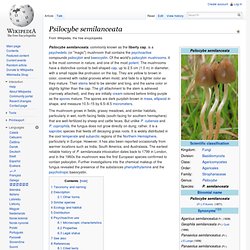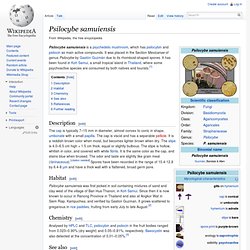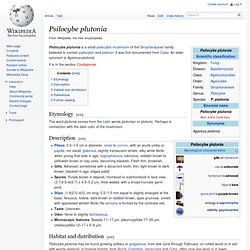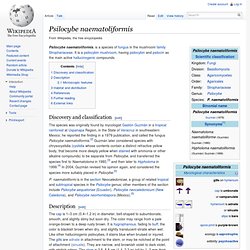

Psilocybe stuntzii. Psilocybe stuntzii, also known as Stuntz's Blue legs and Blue Ringers it is a psilocybin mushroom of the Strophariaceae family, having psilocybin and psilocin as main active compounds.

Psilocybe semilanceata. The mushroom grows in fields, grassy meadows, and similar habitats, particularly in wet, north-facing fields (south-facing for southern hemisphere) that are well-fertilized by sheep and cattle feces.

But unlike P. cubensis and P. coprophila, the fungus does not grow directly on dung; rather, it is a saprobic species that feeds off decaying grass roots. It is widely distributed in the cool temperate and subarctic regions of the Northern Hemisphere, particularly in Europe. However, it has also been reported occasionally from warmer locations such as India, South America, and Australasia. The earliest reliable history of P. semilanceata intoxication dates back to 1799 in London, and in the 1960s the mushroom was the first European species confirmed to contain psilocybin. Further investigations into the chemical makeup of the fungus revealed the presence of the substances phenylethylamine and the psychotropic baeocystin. Psilocybe serbica. Psilocybe serbica is a species of mushroom in the Strophariaceae family.

The mushroom contains the compound psilocybin. It is closely related to Psilocybe cyanescens, although the latter has a strong farinaceous odor and taste and is not translucent-striate when moist. Psilocybe strictipes. Psilocybe strictipes is a psilocybin mushroom that grows on grassy meadows and lawns; It is found throughout the cool temperate and subarctic regions of the Northern Hemisphere and it is most common in Europe, and the Pacific Northwest region of North America.

It is closely related to Psilocybe semilanceata and Psilocybe pelliculosa. Psilocybe strictipes is commonly confused with Psilocybe semilanceata and can be differentiated by its lack of a papilla and a convex to subumbonate cap. "Strictipes" comes from the Latin words stricti (narrow) and pes (foot). Description[edit] Psilocybe strictipes has a farinaceous smell and taste.
Cap[edit] Gills[edit] The gills are cream-colored when young and dark purple brown when mature, with an adnate attachment. Spores[edit] The spores are dark purple brown, suboblong, and 11 by 6 µm. Psilocybe samuiensis. Psilocybe samuiensis is a psychedelic mushroom, which has psilocybin and psilocin as main active compounds.

It was placed in the Section Mexicanae of genus Psilocybe by Gastón Guzmán due to its rhomboid-shaped spores. It has been found in Koh Samui, a small tropical island in Thailand, where some psychoactive species are consumed by both natives and tourists.[1] Description[edit] Habitat[edit] Psilocybe samuiensis was first picked in soil containing mixtures of sand and clay west of the village of Ban Hua Thanon, in Koh Samui. Psilocybe pelliculosa. Psilocybe plutonia. Psilocybe plutonia is a small psilocybin mushroom of the Strophariaceae family, believed to contain psilocybin and psilocin.

It was first documented from Cuba. An older synonym is Agaricus plutonia. It is in the section Cordisporae. Etymology[edit] The word plutonia comes from the Latin words plutonian or plutonic. Psilocybe quebecensis. Psilocybe quebecensis is a moderately active hallucinogenic mushroom in the section Aztecorum, having psilocybin and psilocin as main active compounds.

Native to Quebec, it is the most northern known psilocybin mushroom.[1] Macroscopically this mushroom somewhat resembles Psilocybe baeocystis. Etymology[edit] Named for the province Quebec, where it was discovered. Psilocybe naematoliformis. Discovery and classification[edit] The species was originally found by mycologist Gastón Guzmán in a tropical rainforest at Uxpanapa Region, in the State of Veracruz in southeastern Mexico; he reported the finding in a 1979 publication, and called the fungus Psilocybe naematoliformis.[2] Guzmán later considered species with chrysocystidia (cystidia whose contents contain a distinct refractive yellow body, that become more deeply yellow when stained with ammonia or other alkaline compounds) to be separate from Psilocybe, and transferred the species first to Naematoloma in 1980,[3] and then later to Hypholoma in 1999.[4] In 2004, Guzmán revised his opinion again, and considered the species more suitably placed in Psilocybe.[5] Description[edit] Microscopic features[edit] The spores have dimensions of (3.8)4.9–5.5(6.6) by (3.3)4.4–5(6.6) by 3.8–4.4 μm, sublentiform (shaped somewhat like a biconvex lens) in face view or roughly elliptic in side view, with an inconspicuous hilar appendage.

Psilocybe neoxalapensis. Psilocybe ovoideocystidiata. Psilocybe ovoideocystidiata spores Etymology[edit] From the frequent ovoid both pleuro- and cheilocystidia.

Psilocybe mexicana. Psilocybe mexicana is a psychedelic mushroom.

It was first used by the early natives of Central America and North America over 2,000 years ago. Known to the Aztecs as teonanácatl from Nahuatl: teotl "god" + nanácatl "mushroom. " Psilocybe mescaleroensis. Psilocybe mescaleroensis is a psychedelic mushroom which has psilocybin and psilocin as main active compounds. This mushroom is closely related to Psilocybe stuntzii. It was brought to scientific attention by Lee Walstad. Description[edit] Cap: 2 - 6 cm, convex to subumbonate, brownish-yellow, hygrophanous, margin striate when moist, often with an orangish center, broad umbo and wavy margin. Has a separable gelatinous pellicle. Psilocybe meridionalis. Psilocybe meridionalis is a psychedelic mushroom which has psilocybin and psilocin as main active compounds. This mushroom is closely related to Psilocybe stuntzii but can be distinguished by its smaller spores and the presence of pleurocystidia.
This is the only species of Psilocybe from section Stuntzii which has been found in Mexico. It is known only from the mountains of western Jalisco, Mexico. Psilocybe makarorae. Taxonomy[edit] The species was first mentioned in the literature in 1981, when Pierre Margot and Roy Watling described a specimen collected in 1969 by Grace Marie Taylor near the Franz Josef Glacier as an unnamed Psilocybe with affinities to the North American species Psilocybe caerulipes.[1] It was officially described as new to science in 1995 by mycologists Peter R.
Johnston and Peter K. Buchanan.[2] In his 1996 book Psilocybin Mushrooms of the World, Paul Stamets noted that the two authors are known to work with law-enforcement officials to assist in prosecuting those who illegally collect psychoactive mushrooms.[3] Description[edit] Caps have an acute, sometimes papillate (nipple-like) umbo. Remnants of the partial veil on the stem The spore print is dark purplish-brown. Psilocybe muliercula. Psilocybe muliercula is a species of entheogenic mushroom in the Strophariaceae family.[2] This mushroom is native to Mexico and contains the compounds psilocybin and psilocin. Psilocybe muliercula is in the section Zapotecorum along with Psilocybe angustipleurocystidiata, Psilocybe argentipes, Psilocybe aucklandii, Psilocybe barrerae, Psilocybe collybioides, Psilocybe graveolens, Psilocybe kumaenorum, Psilocybe microcystidia, Psilocybe pintonii, Psilocybe sanctorum, Psilocybe subcaerulipes, and Psilocybe zapotecorum.
Unable to locate this species in the field, botanist Roger Heim and mycologist Rolf Singer based their descriptions of this mushroom on dried specimens purchased from Matlatzinca Indians in the marketplace of Tenango del Valle, in the Nevado de Toluca region of the state of Mexico. Psilocybe muliercula is known to grow in Abies and Pinus forests at elevations of 3150–3500 and 2600–2800 meters, respectively. Psilocybe hoogshagenii. The species is found in Mexico, where it grows singly or in small groups in clayey soils in subtropical coffee plantations, and from Colombia and Brazil in South America.
The mushroom contains the psychedelic compounds psilocybin and psilocin, and all parts will stain blue or bluish black when handled or injured. P. hoogshagenii is used for divinatory purposes by some indigenous groups in Mexico. Psilocybe hispanica. Taxonomy[edit] Psilocybe inquilina. Deconica inquilina is a species of mushroom in the Strophariaceae family. Formerly a member of the genus Psilocybe (well known for its psilocybin containing members), this species belonged to the non-blueing (non-hallucinogenic) clade[1] and was consequently moved to Deconica in 2009.[2] Psilocybe galindoi. Psilocybe galindoi is a psychedelic mushroom in the section Mexicana, having psilocybin and psilocin as its main active compounds.
It is also known as P. galindii, the mushroom was named in honor of Mr. Psilocybe guilartensis. Psilocybe graveolens. Psilocybe graveolens is an extremely rare psilocybin mushroom in the section Zapotecorum, which has psilocybin and psilocin as main active compounds, discovered in the salt marshes or "meadows" of Hackensack, New Jersey. Psilocybe fimetaria. Psilocybe subaeruginosa. Psilocybe subaeruginosa Cleland is an extremely potent psychedelic mushroom of Australasia, which has psilocybin and psilocin as its main active compounds. First described in 1927 by Australian mycologist John Burton Cleland,[1] it was previously placed in the section Cyanescens.[2] Cyanescens has since been deprecated as a section and so Psilocybe subaeruginosa now falls under the section Semilanceatae.[3] Psilocybe fagicola. Psilocybe fagicola. Psilocybe caerulescens var. caerulescens. Psilocybe cyanofibrillosa. Psilocybe cyanescens.
Psilocybe caerulipes. Psilocybe cubensis. Psilocybe atlantis. Psilocybe azurescens. Psilocybe baeocystis. Psilocybe tampanensis. Psilocybe villarrealiae. Psilocybe weilii. Psilocybe weraroa. Psilocybe zapotecorum. Psilocybe subaeruginascens. Psilocybe subaeruginosa. Psilocybe subcubensis.